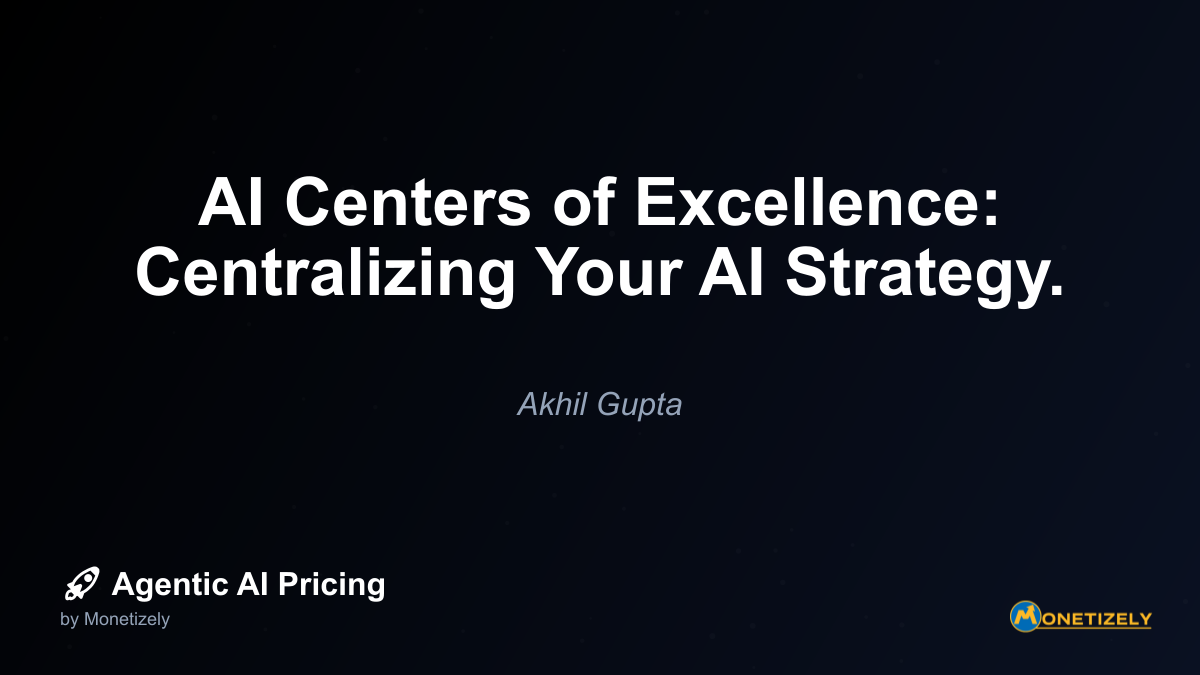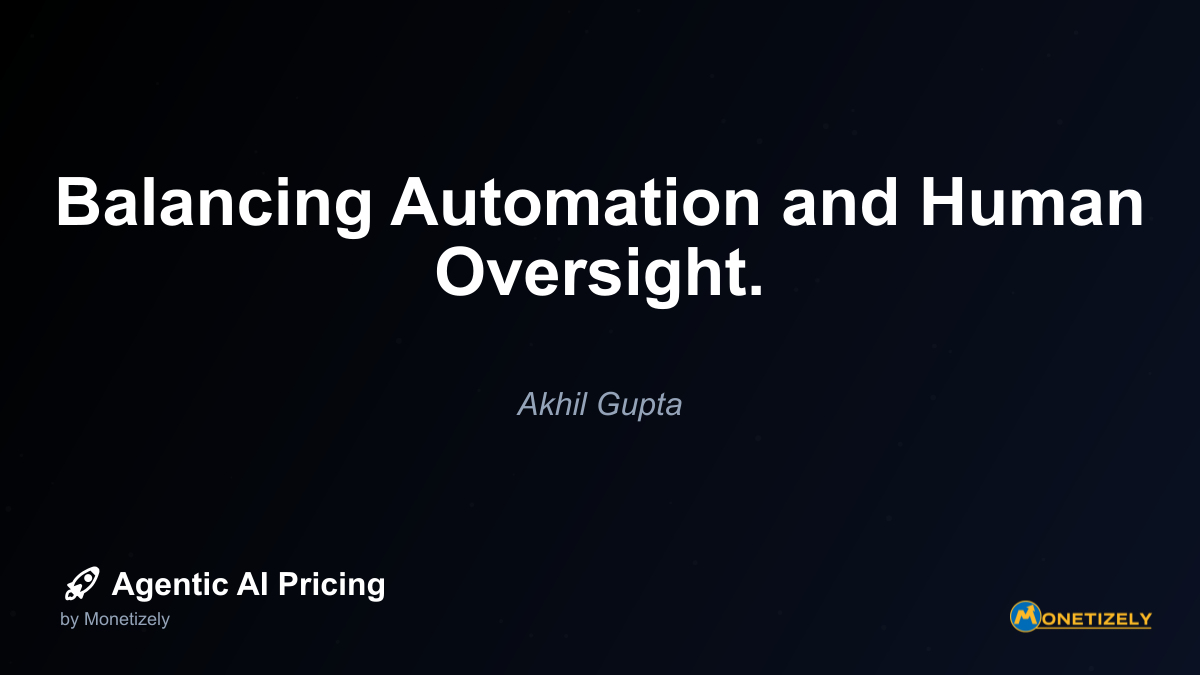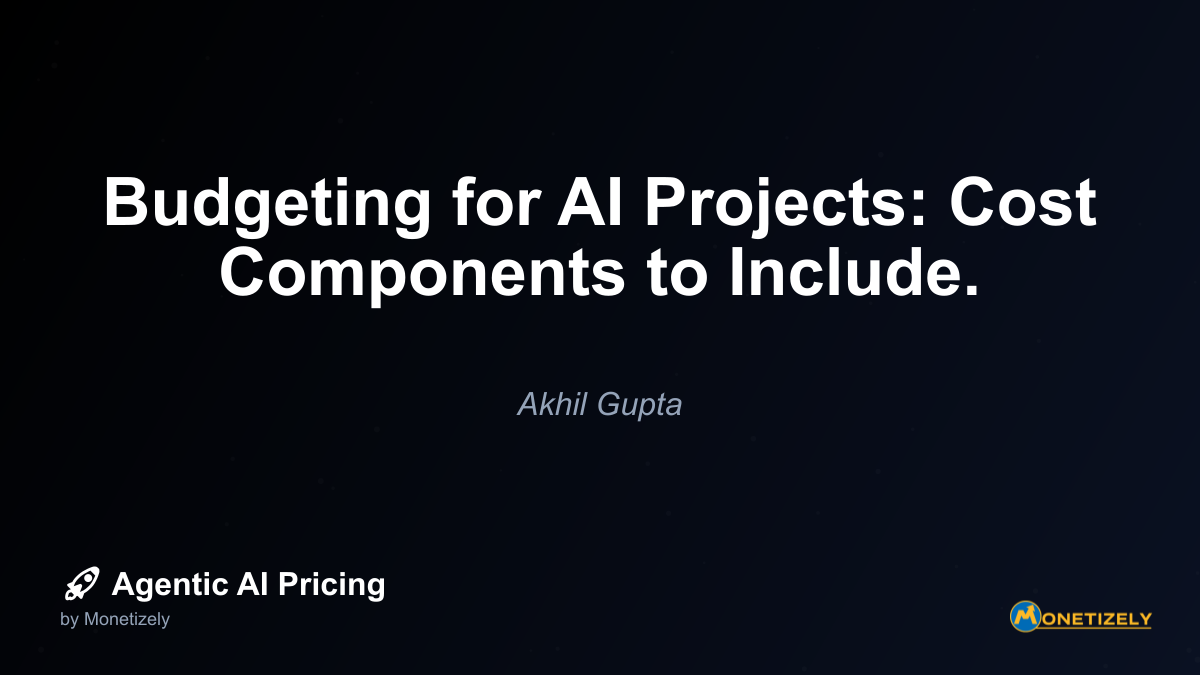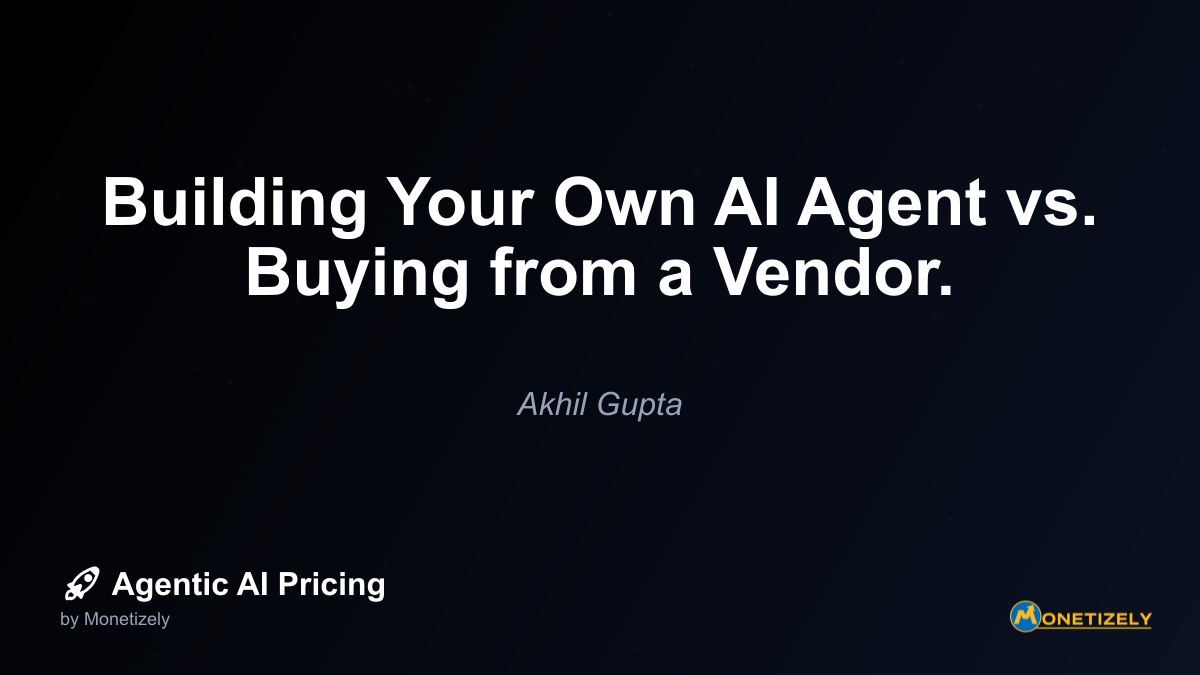· Ajit Ghuman · Implementation Strategies · 10 min read
Setting AI Project Success Criteria and KPIs.
AI and SaaS Pricing Masterclass
Learn the art of strategic pricing directly from industry experts. Our comprehensive course provides frameworks and methodologies for optimizing your pricing strategy in the evolving AI landscape. Earn a professional certification that can be imported directly to your LinkedIn profile.
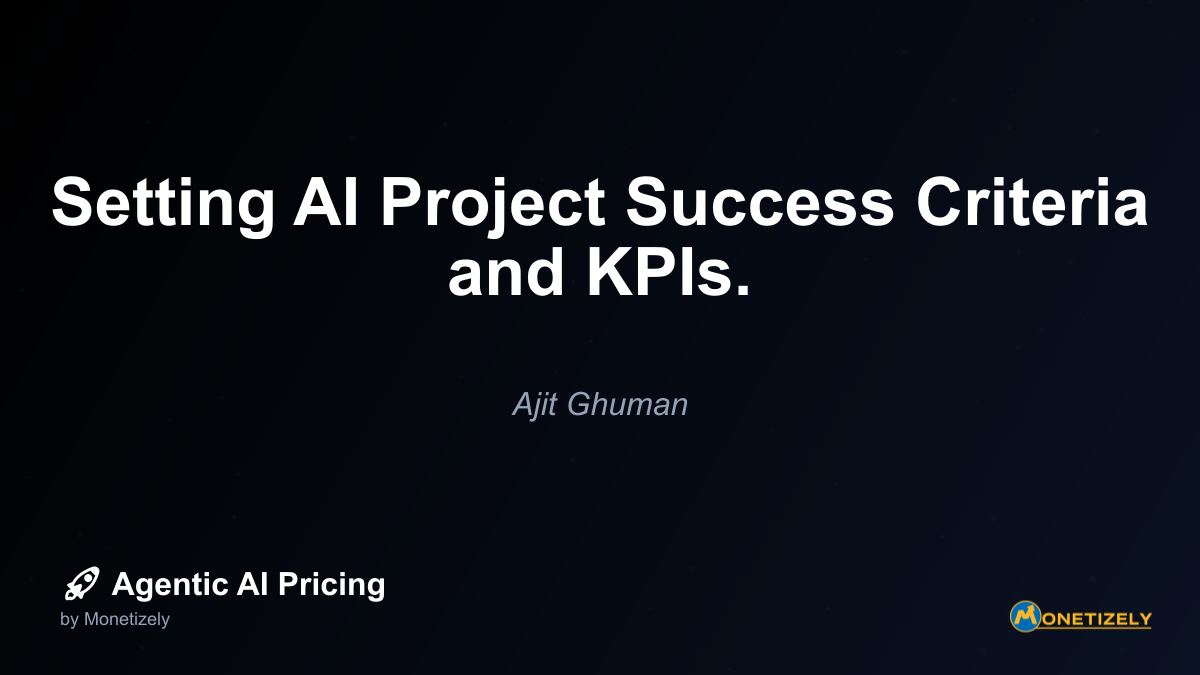
Without proper success criteria, organizations face several challenges:
- Resource misallocation: Continued investment in AI projects that don’t deliver meaningful business outcomes
- Inability to optimize: No clear framework for improving AI system performance
- Stakeholder skepticism: Difficulty demonstrating value to executives and investors
- Misaligned expectations: Disconnect between technical capabilities and business requirements
According to a study by Gartner, nearly 85% of AI projects fail to deliver on their promises, with unclear success metrics being a primary contributor to this high failure rate. Establishing robust success criteria isn’t just good practice—it’s essential for AI project viability.
The Framework for Defining AI Success Criteria
Creating effective success criteria for AI initiatives requires a structured approach that aligns technical capabilities with business objectives. Here’s a comprehensive framework to guide this process:
1. Start with Business Objectives
Every AI project should begin with clear business objectives. These high-level goals provide the foundation for all subsequent success metrics. Common business objectives for AI initiatives include:
- Operational efficiency: Reducing manual effort, streamlining workflows
- Cost reduction: Decreasing operational expenses through automation
- Revenue growth: Increasing sales through improved customer experiences
- Risk mitigation: Detecting fraud, ensuring compliance, reducing errors
- Innovation acceleration: Creating new products or services
For example, a customer service AI might have the primary business objective of improving customer satisfaction while reducing support costs. An AI-powered fraud detection system might focus on reducing false positives while maintaining high detection rates.
2. Define Specific, Measurable Outcomes
Once business objectives are established, translate them into specific, measurable outcomes. These should be concrete results that the AI system will deliver. For each business objective, identify 2-3 key outcomes that represent success.
Example: Customer Service AI
- Business Objective: Improve customer satisfaction while reducing costs
- Measurable Outcomes:
- Reduce average resolution time by 25%
- Increase first-contact resolution rate to 85%
- Decrease support ticket volume by 30%
Example: Fraud Detection AI
- Business Objective: Enhance fraud prevention while minimizing false positives
- Measurable Outcomes:
- Increase fraud detection rate by 15%
- Reduce false positive rate to under 2%
- Identify new fraud patterns not previously detected
The key is ensuring these outcomes are specific, measurable, achievable, relevant, and time-bound (SMART).
3. Establish Baseline Metrics
Before implementing an AI solution, measure current performance to establish baselines. These reference points allow for accurate assessment of the AI system’s impact. Baseline measurements should:
- Cover at least 3-6 months of historical data
- Include seasonal variations when relevant
- Capture both average performance and variance
- Be measured using the same methodology planned for the AI implementation
For example, if your AI project aims to reduce customer support response times, measure the current average response time, peak response times, and response time distribution before implementation.
4. Select Appropriate KPIs
Key Performance Indicators (KPIs) are the specific metrics used to track progress toward your desired outcomes. Effective AI project KPIs fall into several categories:
Technical Performance KPIs
These metrics focus on the AI system’s core capabilities:
- Accuracy: Percentage of correct predictions or actions
- Precision and Recall: Balance between false positives and false negatives
- F1 Score: Harmonic mean of precision and recall
- AUC-ROC: Area under the receiver operating characteristic curve
- Mean Average Precision: For object detection or information retrieval tasks
- Latency: Response time for predictions or actions
- Throughput: Number of predictions or actions per time unit
Business Impact KPIs
These metrics connect AI performance to business outcomes:
- Cost Reduction: Decreased operational expenses, reduced manual effort
- Time Savings: Reduced processing time, faster decision-making
- Revenue Impact: Increased sales, improved conversion rates
- Customer Satisfaction: NPS scores, CSAT improvements
- Employee Productivity: Output per employee, reduced administrative burden
- Error Reduction: Decreased error rates, improved compliance
Operational KPIs
These metrics track the AI system’s integration into business processes:
- Adoption Rate: Percentage of users actively using the AI system
- Utilization: Frequency and duration of AI system usage
- Dependency: Business processes relying on AI outputs
- Maintenance Requirements: Time spent on system updates and refinements
- Integration Effectiveness: Seamless connection with existing systems
ROI Metrics
These metrics quantify the financial return on AI investments:
- Implementation Costs: Development, infrastructure, and deployment expenses
- Operational Costs: Ongoing maintenance, cloud resources, and monitoring
- Time to Value: Duration from project initiation to measurable business impact
- Cost Savings: Direct reduction in operational expenses
- Revenue Generation: New or increased revenue attributable to AI implementation
For a comprehensive view of AI project performance, select KPIs from each category, ensuring they align with your specific business objectives.
How to Set Realistic AI Performance Targets
Setting appropriate targets for AI performance requires balancing ambition with realism. Here’s how to establish meaningful benchmarks:
1. Conduct Competitive Benchmarking
Research industry standards and competitor performance to establish reasonable expectations:
- Analyze published case studies in your industry
- Review vendor benchmarks (while accounting for potential bias)
- Consult industry analysts and research reports
- Network with peers implementing similar AI solutions
This external perspective helps set targets that are competitive yet achievable.
2. Consider Technical Constraints
Different AI applications have inherent performance limitations based on:
- Available training data quality and quantity
- Problem complexity and inherent uncertainty
- State-of-the-art performance for similar tasks
- Infrastructure and computing constraints
For example, in natural language processing, even state-of-the-art systems may achieve only 85-90% accuracy on complex tasks. Setting a 99% accuracy target would be unrealistic and potentially misleading.
3. Implement Progressive Targets
Rather than setting static goals, establish progressive targets that evolve as the AI system matures:
- Initial deployment targets: Focus on matching human performance or current system baselines
- Optimization targets: Incrementally improve beyond baseline after initial deployment
- Maturity targets: Long-term objectives for fully optimized systems
This phased approach acknowledges the learning curve inherent in AI implementations and allows for realistic progress tracking.
4. Account for Interdependencies
Many AI performance metrics have trade-offs that must be considered when setting targets:
- Accuracy vs. speed
- Precision vs. recall
- Customization vs. scalability
- Automation level vs. human oversight
For instance, increasing fraud detection rates typically increases false positives. Your targets should reflect acceptable trade-offs based on business priorities.
Implementing Measurement Systems for AI Success Criteria
Establishing success criteria is only valuable if you can reliably measure performance against them. Here’s how to implement effective measurement systems:
1. Design Data Collection Mechanisms
Implement systems to capture relevant metrics throughout the AI lifecycle:
- Automated logging: Track technical performance metrics through system logs
- Integration with business systems: Connect AI systems with CRM, ERP, or other business platforms to measure impact
- User feedback channels: Collect qualitative feedback from system users
- A/B testing frameworks: Compare AI performance against control groups
- Periodic audits: Schedule regular reviews of AI system outputs
The measurement approach should be designed before implementation and integrated into the AI system architecture.
2. Establish Measurement Frequency
Different metrics require different measurement cadences:
- Real-time metrics: System availability, response time, error rates
- Daily metrics: Usage patterns, adoption rates, output volume
- Weekly metrics: Accuracy trends, business process impacts
- Monthly metrics: Cost savings, revenue impacts, ROI calculations
- Quarterly metrics: Strategic value assessment, competitive positioning
Match measurement frequency to metric volatility and decision-making needs.
3. Create Visualization and Reporting Tools
Transform raw metrics into actionable insights through:
- Executive dashboards: High-level views of key business impacts
- Operational dashboards: Detailed technical and process metrics
- Trend analyses: Performance changes over time
- Variance reports: Deviations from expected performance
- ROI calculators: Financial impact visualizations
These tools should be accessible to all relevant stakeholders and updated at appropriate intervals.
4. Implement Governance Processes
Establish formal processes for reviewing and acting on performance data:
- Regular review meetings: Schedule dedicated sessions to assess AI performance
- Escalation paths: Define procedures for addressing performance issues
- Continuous improvement protocols: Formalize processes for optimizing underperforming areas
- Documentation requirements: Record decisions and actions based on performance data
Governance ensures that measurement leads to action rather than just information collection.
Key Performance Indicators for Common AI Applications
Different AI applications require specialized KPIs tailored to their specific functions and business impacts. Here are recommended metrics for common AI use cases:
Customer Service AI
Technical KPIs:
- Intent recognition accuracy
- Entity extraction precision
- Response appropriateness score
- Conversation completion rate
Business KPIs:
- Average handling time reduction
- First-contact resolution rate
- Customer satisfaction scores
- Support ticket volume reduction
- Agent productivity improvement
- Cost per customer interaction
Predictive Maintenance AI
Technical KPIs:
- Failure prediction accuracy
- False alarm rate
- Prediction lead time
- Model drift measurement
Business KPIs:
- Unplanned downtime reduction
- Maintenance cost savings
- Extended equipment lifespan
- Spare parts inventory optimization
- Technician utilization improvement
Marketing Optimization AI
Technical KPIs:
- Audience segmentation accuracy
- Content recommendation relevance
- Campaign optimization speed
- Attribution model accuracy
Business KPIs:
- Conversion rate improvement
- Customer acquisition cost reduction
- Customer lifetime value increase
- Campaign ROI enhancement
- Time-to-market acceleration
Financial Risk Assessment AI
Technical KPIs:
- Risk classification accuracy
- Early warning detection rate
- Model explainability metrics
- Regulatory compliance score
Business KPIs:
- Default rate reduction
- Fraud loss prevention
- Processing time improvement
- Manual review reduction
- Regulatory penalty avoidance
Supply Chain Optimization AI
Technical KPIs:
- Demand forecast accuracy
- Inventory optimization precision
- Route planning efficiency
- Anomaly detection sensitivity
Business KPIs:
- Inventory carrying cost reduction
- Stockout frequency decrease
- On-time delivery improvement
- Transportation cost savings
- Order fulfillment cycle time reduction
For each application, prioritize the KPIs most aligned with your specific business objectives and use case requirements.
Overcoming Common Challenges in AI Performance Measurement
Measuring AI success presents unique challenges that require thoughtful solutions:
Challenge 1: Attributing Business Impact
Problem: Isolating the specific impact of AI from other business changes can be difficult.
Solutions:
- Implement controlled experiments with A/B testing
- Phase deployments to create natural comparison groups
- Use multivariate analysis to control for external factors
- Create simulation models to estimate counterfactual scenarios
Challenge 2: Handling Model Drift
Problem: AI performance tends to degrade over time as data patterns change.
Solutions:
- Implement continuous monitoring for data and concept drift
- Establish regular retraining and validation cycles
- Set performance thresholds that trigger model reviews
- Maintain version control to compare performance across model iterations
Challenge 3: Balancing Technical and Business Metrics
Problem: Technical teams and business stakeholders often prioritize different metrics.
Solutions:
- Create layered dashboards with appropriate detail levels for different audiences
- Establish clear connections between technical and business metrics
- Implement joint review sessions with technical and business teams
- Develop translation guides for interpreting technical metrics in business terms
Challenge 4: Managing Expectations
Problem: AI capabilities are often overestimated, leading to unrealistic expectations.
Solutions:
- Provide education on AI capabilities and limitations
- Showcase early prototypes to demonstrate actual performance
- Set progressive performance targets with clear timelines
- Communicate both potential benefits and known limitations
Creating a Continuous Improvement Framework for AI Projects
Success criteria shouldn’t be static. Establish a framework for ongoing optimization:
1. Regular Performance Reviews
Schedule structured reviews at consistent intervals:
- Weekly technical performance assessments
- Monthly business impact evaluations
- Quarterly strategic alignment reviews
These sessions should examine current performance against targets and identify improvement opportunities.
2. Root Cause Analysis Protocols
When performance falls short of targets, implement systematic analysis:
- Data quality assessments
- Model architecture reviews
- Process integration evaluations
- User adoption investigations
Document findings and create action plans for addressing identified issues.
3. Feedback Integration Mechanisms
Establish channels for collecting and acting on stakeholder feedback:
- User experience surveys
- Business process owner interviews
- Technical team retrospectives
- Executive sponsor input sessions
This qualitative data often reveals improvement opportunities not visible in quantitative metrics.
4. Performance Optimization Cycles
Implement structured improvement processes:
- Prioritize enhancement opportunities based on business impact
- Develop specific optimization hypotheses
- Implement changes in controlled environments
- Measure results against baseline performance
- Document successful approaches for future implementations
Case Study: AI Success Criteria in Action
To illustrate these principles, consider this case study of a financial services company implementing an AI-powered loan approval system:
Business Objective: Improve loan approval efficiency while maintaining or reducing default rates
Success Criteria Framework:
Baseline Measurements:
- Manual approval process: 48-hour average decision time
- 7% application rejection rate due to incomplete information
- 2.3% default rate on approved loans
- $140 average cost per application processed
Defined KPIs:
- Technical Performance:
- Prediction accuracy: 92%+ for default risk assessment
- Data completeness validation: 98%+ accuracy
- Processing time: < 5 seconds per application
- Business Impact:
- Decision time reduction: 48 hours → 4 hours (target)
- Incomplete application reduction: 7% → 3% (target)
- Default rate: Maintain at 2.3% or lower
- Processing cost: $140 → $40 per application (target)
- Technical Performance:
Measurement System:
- Real-time dashboard for technical metrics
- Weekly business impact reports
- Monthly ROI assessment
- Quarterly strategic review
Phased Targets:
- Phase 1 (3 months): AI-assisted decisions with human review
- Phase 2 (6 months): Automated decisions for low/medium risk applications
- Phase 3 (12 months): Fully automated system with exception handling
Implementation Results:
After six months, the company achieved:
- 90% reduction in decision time (48 hours → 5 hours)
- 57% reduction in incomplete applications (7% → 3%)
- 13% improvement in default rate (2.3% → 2.0%)
- 64% cost reduction per application ($140 → $50)
This structured approach to success criteria enabled the company to:
- Demonstrate clear ROI to executives
- Identify specific optimization opportunities
- Maintain alignment between technical and business teams
- Adjust expectations and targets based on real-world performance
Conclusion: From Measurement to Value Creation
Setting appropriate success criteria for AI projects isn’t merely an administrative exercise—it’s the foundation for creating genuine business value. By establishing clear metrics tied to business objectives, organizations can ensure their AI investments deliver measurable returns.
Effective AI success criteria should be:
- Aligned with strategic business goals
- Specific and measurable
- Balanced across technical and business dimensions
- Realistic yet ambitious
- Adaptable as the AI system matures
As AI continues to transform business operations, the organizations that excel will be those that can clearly articulate what success looks like and systematically measure progress toward those defined outcomes. This disciplined approach transforms AI from an experimental technology into a reliable driver of business value.
By implementing the frameworks and approaches outlined in this guide, your organization can develop AI success criteria that provide both accountability and insight, ensuring your AI initiatives deliver on their promises and contribute meaningfully to business success.
Co-Founder & CEO
Ajit is the author of Price To Scale, a top book on SaaS Pricing and is the Founder of Monetizely. Ajit has led and worked in pricing and product marketing at firms like Twilio, Narvar and Medallia. His work has been featured in Forbes and VentureBeat. Ajit regularly consults with software companies from Seed stage to post-IPO on pricing strategy. Ajit is also a highly-rated co-instructor for 'The Art of SaaS Pricing and Monetization' on Maven.
Pricing Strategy Audit
Let our experts analyze your current pricing strategy and identify opportunities for improvement. Our data-driven assessment will help you unlock untapped revenue potential and optimize your AI pricing approach.

